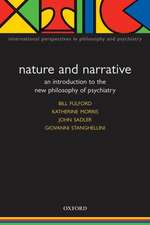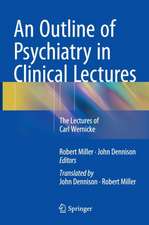An Experiential Approach to Psychopathology: What is it like to Suffer from Mental Disorders?
Editat de Giovanni Stanghellini, Massimiliano Aragonaen Limba Engleză Hardback – 19 aug 2016
An Experiential Approach to Psychopathology, and the method it proposes, may be considered the result of convergence of classic phenomenological psychopathological concepts and updated clinical insights into patients’ lived experiences. It endorses three key principles: subjective phenomena are the quintessential feature of mental disorders; their qualitative study is mandatory; phenomenology has developed a rigorous method to grasp “what it is like” to be a person experiencing psychopathological phenomena. While the book is highly relevant for expert clinical phenomenologists, it is written in a way that will be readily understandable for trainees and young clinicians.
| Toate formatele și edițiile | Preț | Express |
|---|---|---|
| Paperback (1) | 1063.43 lei 43-57 zile | |
| Springer International Publishing – 9 iun 2018 | 1063.43 lei 43-57 zile | |
| Hardback (1) | 1552.72 lei 43-57 zile | |
| Springer International Publishing – 19 aug 2016 | 1552.72 lei 43-57 zile |
Preț: 1552.72 lei
Preț vechi: 1634.44 lei
-5% Nou
Puncte Express: 2329
Preț estimativ în valută:
297.11€ • 311.04$ • 245.84£
297.11€ • 311.04$ • 245.84£
Carte tipărită la comandă
Livrare economică 07-21 aprilie
Preluare comenzi: 021 569.72.76
Specificații
ISBN-13: 9783319299433
ISBN-10: 3319299433
Pagini: 500
Ilustrații: VI, 383 p. 7 illus., 3 illus. in color.
Dimensiuni: 155 x 235 x 22 mm
Greutate: 7.1 kg
Ediția:1st ed. 2016
Editura: Springer International Publishing
Colecția Springer
Locul publicării:Cham, Switzerland
ISBN-10: 3319299433
Pagini: 500
Ilustrații: VI, 383 p. 7 illus., 3 illus. in color.
Dimensiuni: 155 x 235 x 22 mm
Greutate: 7.1 kg
Ediția:1st ed. 2016
Editura: Springer International Publishing
Colecția Springer
Locul publicării:Cham, Switzerland
Cuprins
Introduction to the method of phenomenological psychopathology.- Delusions and Delusion-like ideas.- Hallucinations.- Catatonia.- Autism.- Bodily experiences.- Disturbances of the Self.- Perplexity.- Bizarreness.- Obsessive phenomena.- Melancholia.- Mania.- Dysphoria and anger in borderline disorders.- Depersonalization.- Gender dysphoria.- Aggressiveness.- Self-Injury.- Suicide.- Experiences related to Alcohol and Drug Abuse.- Values and Psychoses.
Notă biografică
Prof. Dr. Giovanni Stanghellini, University “G. D’Annunzio”, Department of Psychological, Humanistic and Territorial Sciences, Chieti, Italy, and University "D. Portales", Santiago, Chile
Prof. Dr. Massimiliano Aragona, Sapienza University, School of Psychiatry. Rome, Italy
Textul de pe ultima copertă
This book introduces the reader to a clear and consistent method for in-depth exploration of subjective psychopathological experiences with the aim of helping to restore the ability within psychiatry and clinical psychology to draw qualitative distinctions between mental symptoms that are only apparently similar, thereby promoting a more precise characterization of experiential phenotypes. A wide range of mental disorders are considered in the book, each portrayed by a distinguished clinician. Each chapter begins with the description of a paradigmatic case study in order to introduce the reader directly to the patient’s lived world. The first-person perspective of the patient is the principal focus of attention. The essential, defining features of each psychopathological phenomenon and the meaning that the patient attaches to it are carefully analyzed in order to “make sense” of the patient’s apparently nonsensical experiences. In the second part of each chapter, the case study is discussed within the context of relevant literature and a detailed picture of the state of the art concerning the psychopathological understanding of the phenomenon at issue is provided.
An Experiential Approach to Psychopathology, and the method it proposes, may be considered the result of convergence of classic phenomenological psychopathological concepts and updated clinical insights into patients’ lived experiences. It endorses three key principles: subjective phenomena are the quintessential feature of mental disorders; their qualitative study is mandatory; phenomenology has developed a rigorous method to grasp “what it is like” to be a person experiencing psychopathological phenomena. While the book is highly relevant for expert clinical phenomenologists, it is written in a way that will be readily understandable for trainees and young clinicians.
An Experiential Approach to Psychopathology, and the method it proposes, may be considered the result of convergence of classic phenomenological psychopathological concepts and updated clinical insights into patients’ lived experiences. It endorses three key principles: subjective phenomena are the quintessential feature of mental disorders; their qualitative study is mandatory; phenomenology has developed a rigorous method to grasp “what it is like” to be a person experiencing psychopathological phenomena. While the book is highly relevant for expert clinical phenomenologists, it is written in a way that will be readily understandable for trainees and young clinicians.
Caracteristici
Describes the subjective experiences of persons with a wide variety of mental disorders Uses detailed case studies to introduce the reader directly to the patient’s lived world Presents challenging concepts in a way that will be understandable for students and clinicians trained in different perspectives














